
In my first year as a Baltimore city school teacher, I saw and experienced many “aha” moments. But one moment stood out, requiring immediate action, follow through, and educational awareness.
Picture a student hard at work, when all of a sudden another student begins making the following sounds: “Boom, Boom, Kaboom, Kaboom, Pew, Pew,” followed by hand gestures that mimicked throwing bombs and shooting guns. One might think these are the actions of boys playing around, but unfortunately, they were the actions of one student toward a classmate of the Muslim faith.
The Muslim student was hard at work when she was subjected to this. Her friend had enough courage to walk up to her teacher, tell her what was happening, and also state that this was not the first time this had happened.
When I heard of this, I was distraught. Our school was filled with diverse students from various economic, cultural, and religious backgrounds, so how could this discrimination happen to middle schoolers and by middle schoolers?
As a first-year teacher, I knew that I needed to address this incident of racial discrimination in my class, but I needed to consider all possible responses to determine the best approach. Was I to discipline the student and point out to the class that this was unacceptable? Was I to report straight to the admin team and have them handle the situation? Was I to circle the two students up for a restorative justice moment? So many factors needed to be considered when weighing the response, including the age of the children involved, the ignorance and bias that can exist between different religions, and the potential conflicts that arise with racial differences. It was clear that this situation had to be handled within a team format.
This was when I realized there was a need for interreligious dialogue and religious awareness within the classroom, school, and school community. The framework for interreligious dialogue and awareness should begin with school staff.
Step 1: Educating the Staff
We should be prepared to discuss topics of religion when present in English Language Arts (ELA) and History courses, without fear of judgment from parents. Educating the staff on the various religions represented in the school would allow them to take the initiative to learn more about them and address them in a culturally aware manner. When students pose questions within social settings, we should be able to have conversations around the subject of knowing at least the basics of various faiths. It should be noted that teachers should not fear not knowing the answer, but should feel comfortable with finding an answer with a student.
Step 2: Communicate with Parents
The next step in tackling interreligious dialogue would be to be open with the parents. They should be aware that there are times when topics of religion are brought up within the curriculum, but that our job is to bring about awareness, not attempt to persuade students on one religion or another. Creating an open dialogue with parents can spark conversations amongst students and families which will aid in student learning.
Step 3: Discuss Boundaries with Students
The last step would be to discuss the boundaries of religious dialogue with students before educating them on the foundations of those religions through the curriculum. Setting the framework for healthy dialogue will allow students to feel safe when these subjects are brought up. This will aid in deeper learning for the students at the end of the day.
In all, this experience has inspired me to take on these steps and work with my school team to implement change in the coming school year.
 Anntasia M. Brown teaches social studies and Special Education at Lakeland Elementary Middle School and was a fellow in the 2022-2023 ICJS Teachers Fellowship. Learn more about the ICJS teacher programs for teachers here.
Anntasia M. Brown teaches social studies and Special Education at Lakeland Elementary Middle School and was a fellow in the 2022-2023 ICJS Teachers Fellowship. Learn more about the ICJS teacher programs for teachers here.
Opinions expressed in blog posts by the ICJS Teacher Fellows are solely the author’s. ICJS welcomes a diversity of opinions and perspectives.